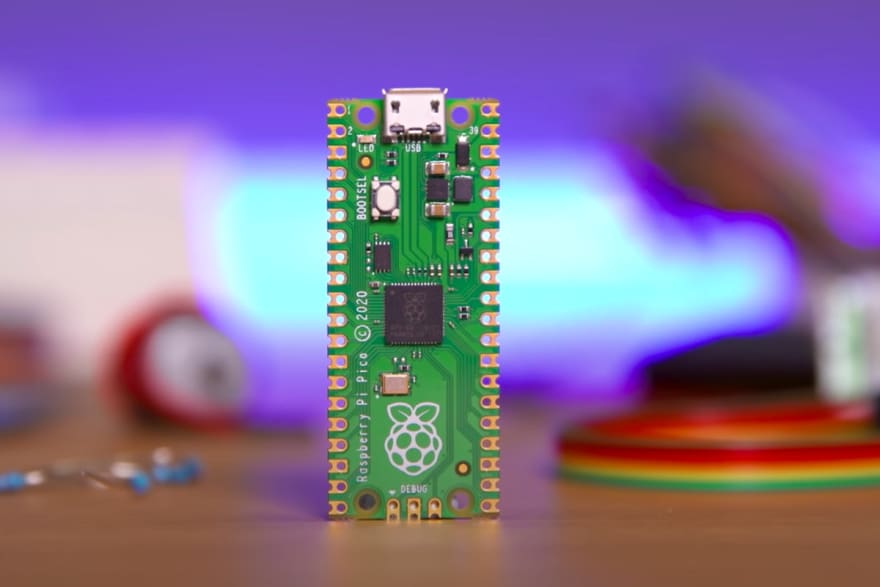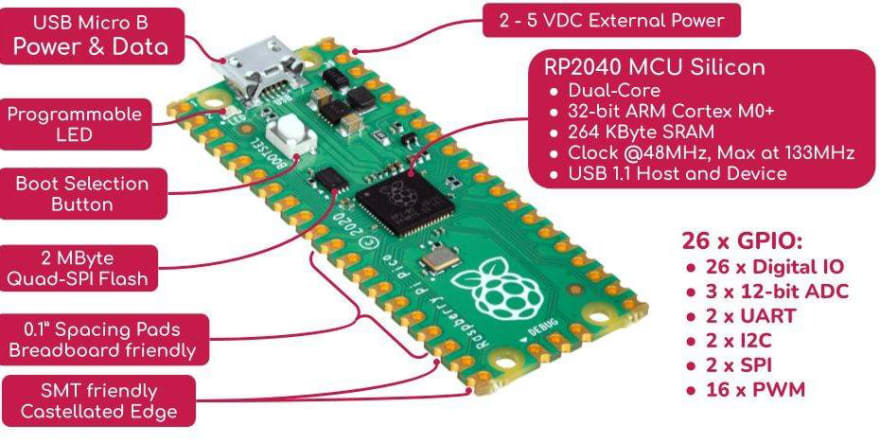The Raspberry Pi is a computer that you can use to learn how to code. With a Raspberry Pi, you can create a robot that follows lines or a music player that streams internet radio. You can also make a smart mirror in your bathroom or even build an arcade where all the games are free!
First things first: What is the Raspberry Pi Pico? The Pico is much smaller than other models in the range and has been designed for use by children aged 7+. Whilst it doesn't have all of the functionality of larger models, it still packs plenty of power and has been built with simplicity in mind.

The smaller size makes it great for children to use as a learning aid. The Pi Pico module uses a different processor from the other models, speeding up the time between code changes, making it easier to learn and experiment with new code. It also has several additional features that the full-size model does not have, such as being able to have more than one screen with video output and being able to connect with all of the Raspberry Pi accessories.
However, unlike the full-size model, you can't plug in a keyboard or mouse when it's in use! Although this doesn't matter too much if you don't need them anyway. If you want to be able to still use your keyboard and mouse, you can connect them to the computer using another USB port.
The second major difference with the Pi Pico is that it has no Ethernet port. This means that if you want to transfer files, you will need to install Wi-Fi. This isn't too tricky though, and with a bit of searching, you'll find plenty of guides online on how to set it up. An Ethernet cable is not hard-wired into the board so it can be easily added later on if needed - but with the Wi-Fi, module installed this will probably never happen!
The final big difference is that it has RCA composite outputs rather than HDMI. This means that you will need to either purchase an adapter cable or build your own using the Raspberry Pi Zero. There is a full guide on how to do this here. You can also use HDMI monitors but you'll just need to get the correct cables for that too, which again there are plenty of guides available online on how to do.

You will need access to a computer to get the NOOBS software onto your SD Card so please read my article on how to install it here. Once you have got your hands on the Raspberry Pi Pico, you will need some accessories so that you can get started. These are:
Raspberry Pi Pico Board, which you can purchase:
- Micro SD Card to store the NOOBS software on. You will need at least an 8 GB card with Class 10 or UHS-1 memory. I recommend the Transcend High Endurance 128GB Micro SD Card. It's very high quality and is one of the most reliable cards in my experience. USB Power Supply Unit, I recommend this one.
- HDMI Cable for connecting your Pi to the monitor. You can purchase one here
- An HDMI monitor or TV to connect your Pi Pico to, you can purchase one here.
- USB Keyboard and Mouse (you can use these if you want). Please note that the keyboard and mouse will both need to be USB devices. If you want to use an older PS/2 keyboard and mouse, then I recommend buying a separate PS/2-to-USB adapter like this.
What kind of things can I do with my Raspberry Pi Pico?
There are so many things you can do with this computer! From creating a music player using the Zero DAC, to coding your games and web browser, there is nothing you cannot build! There is a full guide on exactly how to use it here.
What if I want to connect my Raspberry Pi Pico to the internet?
If you want to connect your Pi Pico to the internet, you can do this using one of the following ways:
- Connecting it into a local Wi-Fi network. You can then share files using an FTP server or using your home computer's web browser. For instructions on how to do this, please see my article on setting up a Wi-Fi network here.
- Connecting it into WAN (Wide Area Network). This is much more complicated as there are so many different ways you can do it, but it is possible with some effort. Again, please see my article on setting up a WAN here.
What programming languages does the Pico use?

The Pico uses a version of Scratch called Scratch 2.0. You can use this to create interactive stories, animations, and games. It is the perfect language to get you started with coding. There is a full guide on exactly how to use it here.
Does the Pico support legacy software?
Legacy software is code that runs on Raspberry Pi models 1 and 2. Legacy software is not supported on the Pico, so you can't run it on your Pico. If you want to use legacy software on your Pico, you will need to buy a full-size model of the Pi. There are two types of legacy software:
- Software that uses an SD card image file such as Scratch 2.0 and BBC micro: bit. These files will not run on the Pi Pico unless you have a full-size model and convert them to a .img file with xbian (which takes a while!).
- Software that is an SD card image file. This type of software will run on the Pi Pico, but it will need to be recompiled. There are several tutorials available online about how to compile legacy software so you can edit them however you want to.
Is this like any other computer?
The Raspberry Pi is quite different from your regular old desktop and laptop computers, thanks to it being an open-source computer. Open source means that all of the code that makes the computer work is visible and editable by anyone who wants to make it better for everyone else using it. Another key difference is that the Pi is always connected to the internet and because of this you can install software like Scratch 2.0, install Google Chrome or Firefox, and even get the latest updates for your operating system (Operating System: Arm64 (Debian) or Raspbian).
What is faster?
The Raspberry Pi 2 has twice the CPU speed of its predecessor, but it's got more RAM too - so not only can programs run faster on it, they can use more RAM too! The Raspberry Pi 3 has even more CPU speed, but no more RAM so you will not be able to run any legacy programs on it.
If you will be running many programs simultaneously on the Pi, then the Raspberry Pi 2 is probably your best choice. It can run both Scratch 2.0 and BBC Micro: bit (and I think the BBC Micro: Bit can run Scratch 2.0).



Top comments (1)
I think this post is very confused between the Pico and the full Raspberry Pi. You might want to clarify it.